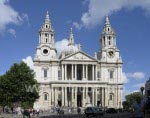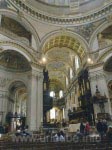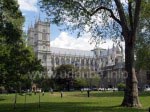|
|
Churches and Cathedrals in London
London offers some of the most significant church buildings of the world, there is only to mention the Westminster Abbey or the die St. Paul's Cathedral. But beside these huge gorgeous buildings, there are still numerous smaller, often not less beautiful or also nonstandard arquitecture as for example Westminster Cathedral. St. Paul's CathedralThe impressive cuppola of the St. Paul's Cathedral is widely visible over the City of London; With a height of 110 m ,it is, after St. Peters in Rome, the second highest of the world. But not only the cuppola contributes to the imposing impression of the cathedral. The whole building with its massive nave, the neo-clasical front at the western main entrance and the big perron make St. Paul's to be the most impressive church building of London. 
The ground on which St. Paul's stands is full of history. Already around the year 600, the first church supposedely stood here, a woodwork at that time. Several fires made sure that at this spot, further 5 churches were consecutively built. Then, around the year 1087, the Normans started with the new building of a cathedral, that, after the completion in the year 1314, it counted to the longest and highest buildings of the medevial times. During the time of Henry VIII., a decay in the church building began and additionally, the tower was destroyed by a lightning strike. The provisional end was provided by the big fire of London in the year 1666. 
The apparently most famous arquitect of London of that time, Sir Christopher Wren, designed, beside many other buildings, the St. Paul's Cathedral. His model was the St. Peter's Basilica in Rome, from which the high similarity of the two buildings result. After 40 years of construction period, the church was completed at the beginning of the 18th century. The Krypta is a special sightseeing that extends underneath the whole space of the church and where there are numerous tombs of famous personages. Of course, also the one of the arquitect Christopher Wren is amongst them. Further celebrities who got a monument set here are, among others, the discoverer of penicillin Alexander Fleming, the commander of the fight against Napoleon, Duke of Wellington and Admiral Nelson, the heroe of the ocean battle of Trafalgar. The church nave, 170 m long and 75 m wide, the altars and the oak choir stalls are additional treasures that make the St. Paul's Cathedral so unique. 
What is really recommendable is the arrangement of the tower or, to be more exactly, the ascent of the cuppola. We can only recommend this to those who do not get soon out of puff, as this is needed if one wants to climb the total of 426 stairs up to the upper view, the Golden Gallery. The good thing is that these 426 stairs do not have to be conquered at once. The ascend to the tip of the cuppola is subdivided in several stages, so that in any case, it is possible to have a break in between. The first stage leads over 143 stairs to the triforium gallery and to the trophy hall, where the plans and models of the former churches and Wrens' plans are exhibited; At this level there is also the Whispering Gallery. On this circle-shaped gallery, one can have a look from all sides to the interior of the church and the paintings of the cuppola. During an eventual conversation one should thoroughly think of what to say, even if only by whispering. Finally, the galery does not have such a name for nothing. Due to its acoustical particularity, one hears everything, even the whispered words coming from the opposite side. Up to the next stage, the Stone Gallery, there are 117 stairs. On the platform of the gallery, one can circle the cuppola and one also has a wonderful view over London. Those who want to get higher can take the remaining 166 stairs. This way is quite steep and narrow, so that it is arranged as a "rail road". One gets up through an ascension and down back at the other side. It is also very narrow in the Golden Gallery, but the view is definitely worthwhile. We brought ourselves to climb up to the Golden Gallery despite our heavy legs and loud wheezing and were rewarded with an unforgettable view; Not earlier than up here it is possible to cast a glance over the church building underneath with the 47 m heighted towers at the west side. In the right tower there is the biggest bell of England, the nearly 17 tons weighted "Great Paul". 

Right beside St. Paul's, a plaza of modern arquitecture catches one's eye, the Paternoster Square. It is a plaza that, according to our opinion, was impressively built with the resources modern arquitecture provides. The effect of the space formation comes into its own by looking down to it from above. The St. Paul's Cathedral is opened from monday to saturday from 8.30 a.m. to 05.00 p.m., the last admittance is at 04.00 p.m. On Sundays, it is closed and/or only visitors of the church service have access. But according to our experience it is possible that the cathedral is also closed during the normal opening times due to the church service. Thus, we had to "clear the field" before 04.00 a.m.". The entrance fee of 10 pounds for an adult is not really cheap. But the ownwers of a London passport are in advantage, as for them, the entrance is for free. A further advantage for them is that they can get in straight away without having to queue. The best way to get to St. Paul's Cathedral is by subway up to the station St. Paul's. Also the way on foot is recomendable over the Millennium Bridge, the view is remarkable. Westminster CathedralIt is surprising standing in the proximity of Victoria Station in front of a church building with a romantic - byzantine brick front. This is not the way one generally imagines a catholic church. Anyway, it is one of the most significant god houses of England, the Westminster Cathedral. 
This unusual chuch building was built between 1895 and 1903 in the footprint of a basilica. A further particularity is the widest nave of England with a width of 52 m. Also concerning the inner arrangement, the church has a lot to offer, as for example two columns that with their red granite should symbolize the blood of jesus. Those who were in St. Peters in Rome will be amazed to find the bronze picture of St. Peter from the dome in the Westminster Cathedral. But the thing is very simple, as it is a copy. In the crypt of Westminster Cathedral one can admire some fragments of the sacred crucifix. During the evening, we found the church to be specially beautiful when it was illuminated by floodlights and outperformed in a warm yellow colour from the blue sky. Then, the ornaments of the brick front come out in a specially impressive way. But also during the day the church offers a special experience, as one can "ascend" the 94 m heighted St. Edward's Tower by lift. The reward of this side trip is an outstanding view to London, provided the weather is more or less fine. The look-out is daily opened from 09.00 a.m. to 05.00 p.m., but during the time from November to March only from Thursday to Sunday. One can get to the Westminster Cathedral by subway up to Victoria Station or with one of the numerous bus lines that also stop at Victoria Station. Westminster AbbeyWestminster Abbey, built in gothic architectural style and situated at immediate vicinity to the Houses of Parliament is one of London's touristical highlights that should not be missed during the visit of the city. 
It is the church of coronations, as here, all english Kings and/or Queens were coronated since the times of William the Conqueror. Traditionally, this ceremony is accomplished by the archbishop of Canterbury. But Westminster Abbey is also the church of the sepulchres, apparently there is no other godhouse in which there are so many personages buried as in this church. In the long list of famous names there are also numerous Kings, Princes and Princesses and also the legendary Elisabeth I., Queen of England, and Maria Stuart, Queen of Scottland, are united in the same church through their tombs. But not only royals have their sepulchre here in the Abbey, also other celebrities were buried here. The author Charles Dickens, the scientist Charles Darwin and Isaac Newton, the musician Georg Friedrich Händel, they are only a few of the squad of the represented in Abbey. 
Since William the Conqueror it is the coronation church, but the history of the church building goes far more back, that is to the beginning of the 7th century. By this time, the church was supposed to be already there. After the destruction and the refoundation by Edward the Confessor, the building of the present church finally begun by Henry III. In the course of the centuries, numerous rebuildings and expansions followed. Today, Westminster Abbey is a building of 156 m length and a a of 61 m. With 34 m, the nave that is arranged in gothic style is the highest of England. 
The exterior of Westminster Abbey is already impressive, but the interior outperforms many things one is used to from churches with its massive size, the abundantly ornamented ceilings and walls, its numerous statues, sepulchres and monuments. One should not miss the view to the church in the evening, when it is illuminated by floodlights. Anyway, we were impressed. A further tip are the dominical organ recitals that take place at 05.45 p.m. and are free of charge. Otherwise, the opening times are from Monday to Friday from 09.30 a.m. to 04.45 Uhr p.m., on Wednesdays up to 06.00 p.m. and Saturdays up to 02.45 p.m. The last admittance is one hour before closing respectively. But usually, the rush is very strong, so that one has to expect some long waiting times. The visit is organized as a round trip that starts at the northern portal and ends at the west portal. The entrance fee is of 6 pounds per adult. St. Martin-in-the-FieldsSt. Martin-in-the-Fields at the Trafalgar Square is also one of london's very old and significant churches. In the year 1222 it was mentioned for the first time. The chuch belonged to the buildings that survived the big city fire of London in the year 1666, but in the year of 1721 it was demolished. At its place, the church building that still exists today was built after the plans of James Gibbs. 
With the column portal and the slim tower heighted 56 m, James could manage to create a very attractive arquitecture that then served the North American colonists as a model for many of their churches. Also the elliptic grid cover in the interior of the church is very beautiful, it was designed by the Italians Arturi and Bagutti . St. Martin-in-the-Fields is not only well done in its arquitecture, but it also has a big significance due to another reason, as the Buckingham Palace belongs to this community, so that by this way it became the church of the royal house. In the royal loge, the royals take part in some of the church services. In front, there is the loge of the admiralty, as St. Martin-in-the-Fields is also a church of the admiralty. A further particularity is the public coffee bar in the crypt, an unusual arrangement for a church. Here, a lunch or a snack is offered depending on the wish, and it has a double effect. First, the guest is usually satisfied, secondly, the profits of the coffee bar are used for people in need. One can get to the St. Martin-in-the-Fields by subway up to the station Charing Cross or with one of the bus lines to the Trafalgar Square. Some More Well Worth Seeing Churches of LondonAccording to a legend, the Southwalk Cathedral goes back to the daughter of a ferryman who founded a convent. The bishop of Winchester had a church built that burned down. At its place, a new church building of the year 1207 was initiated, of which some foundations of the today's Southwalk Cathedral are originally. The cathedral is held in gothic style, the sanctuary is supposed to be one of the oldest gothic eclesiastic architectures of London. What is worth to mention is the monument of William Shakespeare at the southern side aisle. The church is daily opened from 08.00 a.m. up to 06.00 p.m., the entrance is free for those who have a London passport. 
All Souls, it is said the church is similar to a wedding cake, really has an unusual arquitecture. In a small circle-shaped column porch, a very filigree tower stands surrounded by some free standing columns. The church was built from 1822 to 1824 by John Nash. The church is less known and art historically surely not as worth as St. Paul's or Westminster Abbey, but a side trip to visit it is worth the effort due to its unusual arquitecture. St. Mary-le-Bow is one of the oldest stone churches of London. During the big fire of the year 1666 it was destroyed as many other buildings and rebujilt by Christopher Wren, the man who contributed so much to the arquitecture of London. What is noticeable is the nearly 3 m long dragon-shaped weather vane that is fixed at the 73 m heighted tower. The bells of the church were very significant during a long time. Since the medieval times, the Great Bell sounded every morning to wake up the people of London and in the evenings in order to send them to bed at exactly 09.00 p.m. The best way to get to St. Mary-le-Bow is by subway up to the station St. Paul's. 
Author: Michael Nitzschke, Copyright: Patrick Wagner, www.tourist-guide.biz |
||